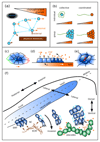Modelling collective cell migration of neural crest
- PMID: 27085004
- PMCID: PMC5017515
- DOI: 10.1016/j.ceb.2016.03.023
Modelling collective cell migration of neural crest
Abstract
Collective cell migration has emerged in the recent decade as an important phenomenon in cell and developmental biology and can be defined as the coordinated and cooperative movement of groups of cells. Most studies concentrate on tightly connected epithelial tissues, even though collective migration does not require a constant physical contact. Movement of mesenchymal cells is more independent, making their emergent collective behaviour less intuitive and therefore lending importance to computational modelling. Here we focus on such modelling efforts that aim to understand the collective migration of neural crest cells, a mesenchymal embryonic population that migrates large distances as a group during early vertebrate development. By comparing different models of neural crest migration, we emphasize the similarity and complementary nature of these approaches and suggest a future direction for the field. The principles derived from neural crest modelling could aid understanding the collective migration of other mesenchymal cell types.
Copyright © 2016 Elsevier Ltd. All rights reserved.
Figures


Similar articles
-
Modelling collective cell migration: neural crest as a model paradigm.J Math Biol. 2020 Jan;80(1-2):481-504. doi: 10.1007/s00285-019-01436-2. Epub 2019 Oct 5. J Math Biol. 2020. PMID: 31587096 Free PMC article.
-
Cell traction in collective cell migration and morphogenesis: the chase and run mechanism.Cell Adh Migr. 2015;9(5):380-3. doi: 10.1080/19336918.2015.1019997. Epub 2015 Aug 12. Cell Adh Migr. 2015. PMID: 26267782 Free PMC article.
-
Multidisciplinary approaches to understanding collective cell migration in developmental biology.Open Biol. 2016 Jun;6(6):160056. doi: 10.1098/rsob.160056. Open Biol. 2016. PMID: 27278647 Free PMC article. Review.
-
Rules of collective migration: from the wildebeest to the neural crest.Philos Trans R Soc Lond B Biol Sci. 2020 Sep 14;375(1807):20190387. doi: 10.1098/rstb.2019.0387. Epub 2020 Jul 27. Philos Trans R Soc Lond B Biol Sci. 2020. PMID: 32713298 Free PMC article. Review.
-
Epithelial-to-mesenchymal transition and different migration strategies as viewed from the neural crest.Curr Opin Cell Biol. 2020 Oct;66:43-50. doi: 10.1016/j.ceb.2020.05.001. Epub 2020 Jun 9. Curr Opin Cell Biol. 2020. PMID: 32531659 Free PMC article. Review.
Cited by
-
Modelling collective cell migration: neural crest as a model paradigm.J Math Biol. 2020 Jan;80(1-2):481-504. doi: 10.1007/s00285-019-01436-2. Epub 2019 Oct 5. J Math Biol. 2020. PMID: 31587096 Free PMC article.
-
Collective Signal Processing in Cluster Chemotaxis: Roles of Adaptation, Amplification, and Co-attraction in Collective Guidance.PLoS Comput Biol. 2016 Jul 1;12(7):e1005008. doi: 10.1371/journal.pcbi.1005008. eCollection 2016 Jul. PLoS Comput Biol. 2016. PMID: 27367541 Free PMC article.
-
Tempos and modes of collectivity in the history of life.Theory Biosci. 2021 Nov;140(4):343-351. doi: 10.1007/s12064-019-00303-4. Epub 2019 Sep 16. Theory Biosci. 2021. PMID: 31529373 Review.
-
In vivo confinement promotes collective migration of neural crest cells.J Cell Biol. 2016 Jun 6;213(5):543-55. doi: 10.1083/jcb.201602083. Epub 2016 May 30. J Cell Biol. 2016. PMID: 27241911 Free PMC article.
-
Neural crest and cancer: Divergent travelers on similar paths.Mech Dev. 2017 Dec;148:89-99. doi: 10.1016/j.mod.2017.08.002. Epub 2017 Sep 6. Mech Dev. 2017. PMID: 28888421 Free PMC article. Review.
References
-
- Méhes E, Vicsek T. Collective motion of cells: from experiments to models. Integr Biol. 2014;6:831–854. [* A systematic and wide overview of studies in collective cell migration.] - PubMed
-
- Mayor R, Etienne-Manneville S. The front and rear of collective cell migration. Nat Rev Mol Cell Biol. 2016;17:97–109. - PubMed
-
- Coburn L, Cerone L, Torney C, Couzin ID, Neufeld Z. Tactile interactions lead to coherent motion and enhanced chemotaxis of migrating cells. Phys Biol. 2013;10:046002. - PubMed
Publication types
MeSH terms
Grants and funding
LinkOut - more resources
Full Text Sources
Other Literature Sources

